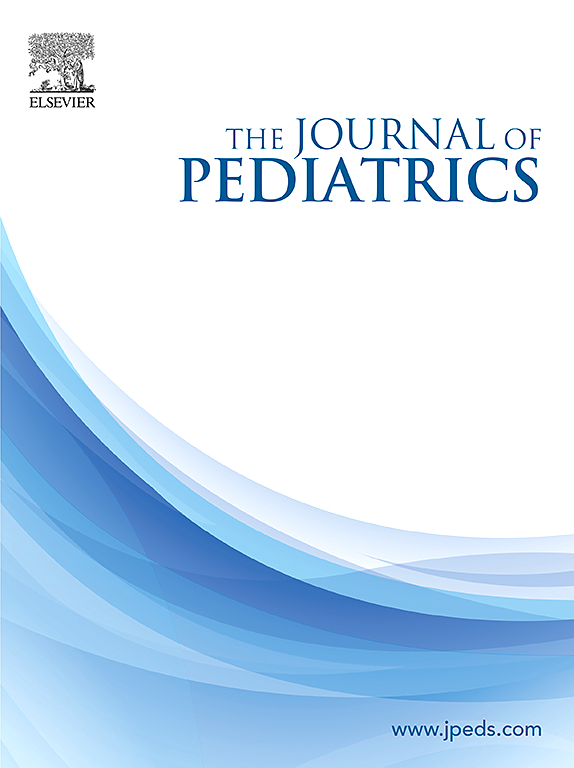Developmental Readiness for Complementary Feeding: Associations with Initiation Before Age 6 Months
IF 3.5
2区 医学
Q1 PEDIATRICS
引用次数: 0
Abstract
Objective
To evaluate whether parents who assess their infants as more developmentally advanced are more likely to begin feeding their infants complementary foods before 6 months, and whether developmental readiness explains racial and ethnic differences in complementary food introduction.
Study design
In a cohort of mothers of 5475 infants from New York state, 9 markers of infant development and timing of initiating complementary feeding were assessed. Mixed effect models assessed associations between developmental markers and initiation of complementary feeding before 6 months term-corrected age. Direct and indirect effects of racial and ethnic differences in complementary feeding through a total development score were computed.
Results
In a fully adjusted model, infant sitting (aOR: 1.60, 95% CI: 1.32, 1.93), head control (aOR: 1.51, 95% CI: 1.26, 1.81), reaching (aOR: 1.19, 95% CI: 1.04, 1.37), mouthing (aOR: 1.26, 95% CI: 1.08, 1.46), and having a good appetite (aOR: 1.61, 95% CI: 1.15, 2.24) were uniquely associated with complementary feeding before age 6 months. A 1-point increase in a total development score was also associated with higher odds of complementary feeding (aOR: 1.26, 95% CI: 1.19, 1.33). The development score explained some racial and ethnic differences in the odds of complementary feeding before 6 months.
Conclusions
Results suggest that parents are using their children's developmental markers to decide when to begin complementary feeding. Furthermore, observations of racial and ethnic differences in the timing of complementary feeding may be explained by perceptions of developmental readiness, in line with recommendations. Future research on complementary feeding should incorporate assessments of infant developmental readiness.
补充喂养的发育准备:与6个月前开始的关联。
目的:评估那些认为婴儿发育更先进的父母是否更有可能在6个月前开始给婴儿喂辅食,以及发育准备是否解释了辅食引入的种族和民族差异。研究设计:对来自纽约州的5475名婴儿的母亲进行队列研究,评估婴儿发育的9项指标和开始补充喂养的时间。混合效应模型评估了发育指标与6个月矫正月龄前开始补充喂养之间的关系。通过总体发展得分计算补充喂养中种族和民族差异的直接和间接影响。结果:在一个完全调整的模型中,婴儿坐位(调整优势比[aOR]:1.60, 95%CI: 1.32, 1.93)、头部控制(aOR:1.51, 95%CI: 1.26, 1.81)、伸手(aOR:1.19, 95%CI: 1.04, 1.37)、口腔喂养(aOR:1.26, 95%CI:1.08, 1.46)和良好的食欲(aOR:1.61, 95%CI:1.15, 2.24)与6个月前的补充喂养有独特的关联。总发育评分每增加1分,补充喂养的几率也会增加(aOR:1.26, 95% CI:1.19, 1.33)。发育评分解释了6个月前补充喂养几率的一些种族和民族差异。结论:结果表明,父母正在使用他们的孩子的发育标记来决定何时开始补充喂养。此外,根据建议,对补充喂养时间的种族和民族差异的观察可以用对发育准备程度的看法来解释。未来关于补充喂养的研究应纳入对婴儿发育准备程度的评估。
本文章由计算机程序翻译,如有差异,请以英文原文为准。
求助全文
约1分钟内获得全文
求助全文
来源期刊

Journal of Pediatrics
医学-小儿科
CiteScore
6.00
自引率
2.00%
发文量
696
审稿时长
31 days
期刊介绍:
The Journal of Pediatrics is an international peer-reviewed journal that advances pediatric research and serves as a practical guide for pediatricians who manage health and diagnose and treat disorders in infants, children, and adolescents. The Journal publishes original work based on standards of excellence and expert review. The Journal seeks to publish high quality original articles that are immediately applicable to practice (basic science, translational research, evidence-based medicine), brief clinical and laboratory case reports, medical progress, expert commentary, grand rounds, insightful editorials, “classic” physical examinations, and novel insights into clinical and academic pediatric medicine related to every aspect of child health. Published monthly since 1932, The Journal of Pediatrics continues to promote the latest developments in pediatric medicine, child health, policy, and advocacy.
Topics covered in The Journal of Pediatrics include, but are not limited to:
General Pediatrics
Pediatric Subspecialties
Adolescent Medicine
Allergy and Immunology
Cardiology
Critical Care Medicine
Developmental-Behavioral Medicine
Endocrinology
Gastroenterology
Hematology-Oncology
Infectious Diseases
Neonatal-Perinatal Medicine
Nephrology
Neurology
Emergency Medicine
Pulmonology
Rheumatology
Genetics
Ethics
Health Service Research
Pediatric Hospitalist Medicine.
 求助内容:
求助内容: 应助结果提醒方式:
应助结果提醒方式:


